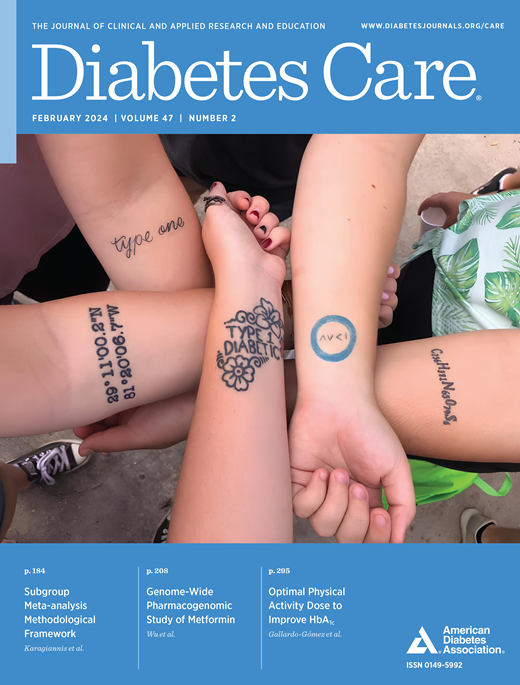Risk of Infection in Older Adults With Type 2 Diabetes With Relaxed Glycemic Control
IF 14.8
1区 医学
Q1 ENDOCRINOLOGY & METABOLISM
引用次数: 0
Abstract
OBJECTIVE To compare the risk of hospitalization for infection among patients who achieve intensive versus relaxed glycemic control. RESEARCH DESIGN AND METHODS This retrospective cohort study included adults age ≥65 years with type 2 diabetes from an integrated health care delivery system. Negative binomial models were used to estimate incidence rates and relative risk (RR) of hospitalization for infections (respiratory; genitourinary; skin, soft tissue, and bone; and sepsis), comparing two levels of relaxed (hemoglobin A1c [HbA1c] 7% to <8% and 8% to <9%) with intensive (HbA1c 6% to <7%) glycemic control from 1 January 2019 to 1 March 2020. RESULTS Among 103,242 older patients (48.5% with HbA1c 6% to <7%, 35.3% with HbA1c 7% to <8%, and 16.1% with HbA1c 8% to <9%), the rate of hospitalization for infections was 51.3 per 1,000 person-years. Compared with HbA1c 6% to <7%, unadjusted risk of hospitalization for infections was significantly elevated among patients with HbA1c 8% to <9% (RR 1.25; 95% CI 1.13, 1.39) but not among patients with HbA1c 7% to <8% (RR 0.99; 95% CI 0.91, 1.08), and the difference became nonsignificant after adjustment. Across categories of infections, the adjusted RR of hospitalization was significantly higher among patients with HbA1c 8% to <9% only for skin, soft tissue, and bone infection (RR 1.33; 95% CI 1.05, 1.69). CONCLUSIONS Older patients with type 2 diabetes who achieve relaxed glycemic control levels endorsed by clinical guidelines are not at significantly increased risk of hospitalization for most infections, but HbA1c 8% to <9% is associated with an increased risk of hospitalization for skin, soft tissue, and bone infections.放宽血糖控制的 2 型糖尿病老年患者的感染风险
目的 比较强化与放松血糖控制的患者因感染住院的风险。研究设计与方法 该回顾性队列研究纳入了一个综合医疗服务系统中年龄≥65 岁的 2 型糖尿病成人患者。研究采用负二项模型来估算因感染(呼吸道感染、泌尿生殖系统感染、皮肤、软组织和骨骼感染以及败血症)住院的发病率和相对风险 (RR),比较了 2019 年 1 月 1 日至 2020 年 3 月 1 日期间两种血糖控制水平(血红蛋白 A1c [HbA1c] 7% 至 <8% 和 8% 至 <9%)的放松型和强化型(HbA1c 6% 至 <7%)血糖控制情况。结果 在 103,242 名老年患者(48.5% HbA1c 为 6% 至 <7%,35.3% HbA1c 为 7% 至 <8%,16.1% HbA1c 为 8% 至 <9%)中,因感染住院的比例为每千人年 51.3 例。与 HbA1c 为 6% 至 <7% 的患者相比,HbA1c 为 8% 至 <9% 的患者未经调整的感染住院风险显著升高(RR 1.25; 95% CI 1.13, 1.39),但 HbA1c 为 7% 至 <8% 的患者的感染住院风险并不显著(RR 0.99; 95% CI 0.91, 1.08),调整后差异变得不显著。在各类感染中,只有皮肤、软组织和骨骼感染的调整后住院RR在HbA1c为8%至<9%的患者中明显更高(RR 1.33; 95% CI 1.05, 1.69)。结论 达到临床指南认可的宽松血糖控制水平的老年 2 型糖尿病患者因大多数感染而住院的风险不会明显增加,但 HbA1c 为 8% 至 <9% 的患者因皮肤、软组织和骨骼感染而住院的风险增加。
本文章由计算机程序翻译,如有差异,请以英文原文为准。
求助全文
约1分钟内获得全文
求助全文
来源期刊

Diabetes Care
医学-内分泌学与代谢
CiteScore
27.80
自引率
4.90%
发文量
449
审稿时长
1 months
期刊介绍:
The journal's overarching mission can be captured by the simple word "Care," reflecting its commitment to enhancing patient well-being. Diabetes Care aims to support better patient care by addressing the comprehensive needs of healthcare professionals dedicated to managing diabetes.
Diabetes Care serves as a valuable resource for healthcare practitioners, aiming to advance knowledge, foster research, and improve diabetes management. The journal publishes original research across various categories, including Clinical Care, Education, Nutrition, Psychosocial Research, Epidemiology, Health Services Research, Emerging Treatments and Technologies, Pathophysiology, Complications, and Cardiovascular and Metabolic Risk. Additionally, Diabetes Care features ADA statements, consensus reports, review articles, letters to the editor, and health/medical news, appealing to a diverse audience of physicians, researchers, psychologists, educators, and other healthcare professionals.
 求助内容:
求助内容: 应助结果提醒方式:
应助结果提醒方式:


